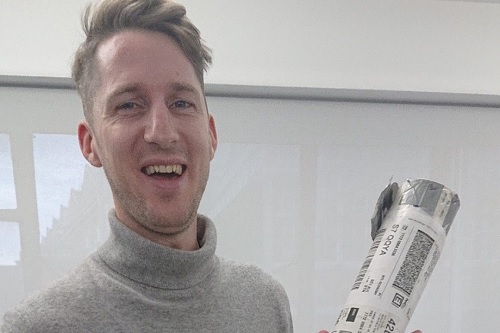Meet the man behind the FloodFlash sensor

Authored by FloodFlash
Our world-leading parametric flood cover simply wouldn’t exist without our IoT-connected sensor. To celebrate the 3rd anniversary of the original prototype, I caught up with FloodFlash design lead Pete Codling. We asked the former Dyson design whiz what drew him to FloodFlash, some of the challenges in developing what has become award-winning technology and what he learned since those early tests in 2018. Here’s what he had to say...
FF: What attracted you to the FloodFlash design role?
PC: The role and the company were very different to what I’d done in the past so my expectations were quite low for the interview. That changed once I met Adam and Ian. I realised the size of the challenge and saw the dynamic between them. It was clear that a rare alchemy was taking place. I wanted to be part of it. I joined a soon as possible and started planning how we could build this together.
Speaking of which, how have you found building a new product from the ground up?
I’ve started businesses before, but the challenges here were on a different scale. We knew we had to build hardware, software, insurance, operations and distribution from scratch. It’s been fascinating and liberating to discover how these different elements evolve and combine into an amazing product. FloodFlash is still a relatively new business but I think we can already be remarkably proud of what we have achieved since those early days.
What are the main challenges building the sensor from scratch?
I’m grateful that the business trusted me to run the development. The autonomy they gave me allowed us to move quickly and make changes right from the word go. I began prototyping and brought on new partners to prototype and get to the best design in a short time.
We knew the customer needs that we wanted to address – making claims faster and more transparent. We also knew that connected hardware would help us get there. The main challenge was deciding the parameters of what the sensor needed to do to fulfil those customer needs. We had to answer a long list of questions, including: what was the maximum water height we wanted to measure, how can we make installation simple, and how do we keep the cost per sensor at an affordable level.
Getting through those initial questions was challenging, but essential in producing a design that works for the customer. After that, the development flowed quickly and we delivered the first sensors earlier than expected, which any designer will tell you is rare.
FloodFlash brings physical and digital product design together. What would you say are the core differences in between how FloodFlash develops digital vs. physical products?
Best practice dictates that in order to make digital products meet customer needs, you need to do the prep before the development. Digital products require rigorous research, design and testing before any development (coding) takes place.
Hardware development is less standardised. Rounds of prototyping and testing often mean greater investment in development, building and testing which product features customers value and which they don’t. It’s hugely beneficial to invest like this though, because the process reveals insights about customers and the business that you wouldn’t otherwise have access to.
What do you think product development could learn from insurance?
Customer relationships. One thing that surprised me when I entered the insurance industry is how much trust exists between brokers and their clients. Clients rely on their broker to help them make the right decisions. Over time we began to factor in how decisions are made when considering design choices. That means incorporating broker needs into any design choices, particularly in how we build and represent the sensor.
If you could change anything about the industry what would it be?
Insurance is a positive force in society, but to stay that way the industry much update some of the more antiquated attitudes and business processes. The market has long held out against the forces of change and I hope that as the industry wakes up to the need for innovation and digitisation. The industry needs more diverse voices and bring people with different backgrounds and experiences to make customer outcomes better. FloodFlash does this really well and it makes me proud to be here – but we can always do more.
Do you think the purpose of product development will change over time at FloodFlash?
The role of design and product development is to stay innovative in everything we do. I don’t think that is going to change. That doesn’t mean we are staying still though. We have started out with a game-changing product, and something that is so fresh in a market ripe for disruption. No we need to push on, constantly improving. That way we can continue to build the business, enter new markets and deliver great value for our clients.
What advice would you give to someone who’s starting out with a new parametric product?
Oh, easy! Know your customer. Listening to feedback is the only way to understand the complex barriers that stand between you and your clients. When launching something that is such a departure from the status quo you will find obstacles, but agile teams that stay alert to customer needs will be the ones that succeed.
To find out more about more about our record-breaking parametric flood insurance CLICK HERE
About FloodFlash
FloodFlash is a new type of rapid-payout flood insurance. It uses the latest data modelling and connected tech to bring parametric insurance to the mass market for the first time. The result is fast, easy and flexible cover that pays claims within days of a flood.
FloodFlash is parametric or `event-based` insurance. When buying the cover, the client chooses the depth of flooding they wish to insure against and how much they’d receive when that flood happens. When the FloodFlash sensor installed at the property detects flood water at the selected depth, the claim is paid in full. No waiting. No haggling.
FloodFlash rapid-payouts were put to the test in February 2020 when Storm Ciara swept across the UK. Claims related to the storm were paid in full within a single day. That speed of claims payment remains the fastest and best proof of mass-market parametric insurance to date gaining acclaim at industry awards and recognition from The Times, The Telegraph and the BBC.
FloodFlash operates across Britain, is headquartered in London. Floodflash is a registered coverholder at Lloyd`s of London and is authorised and regulated by the Financial Conduct Authority.

